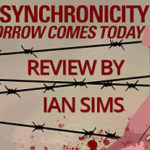Dead Synchronicity: Tomorrow Comes Today – Review
Dead Synchronicity: Tomorrow Comes Today is a good game that missed its chance to be great.







Genre: Point-And-Click Adventure
Release date: April 10, 2015
Dead Synchronicity: Tomorrow Comes Today is a weird game. Brought to life by indie developer Fictiorama, Dead Synchronicity is described as “an old-school 2D graphic adventure game featuring space-time distortions, a dystopian atmosphere…and a dark, bloodstained plot.” Fictiorama has succeeded in many ways by creating a thought-provoking adventure game, but late game failures and frustrating puzzles mar the overall product.
The world has been destroyed by the Great Wave, a mysterious disaster that serves the intrigue of the story. No one knows exactly what it was. All they know is that now there’s no electricity, no communication, and that lots of people have died. And after the Great Wave, the “dissolved” were left behind, as well as the “blankheads.” The dissolved are struck with a horrible disease, writhing in pain as they see visions of the dead before they themselves eventually dissolve into a pool of blood. The blankheads have it better; they suffer from amnesia and can’t remember the Great Wave, a convenient narrative tool to ease the player into the world of Dead Synchronicity.
You play blankhead Michael who starts the game trapped in a refugee camp. From here Michael begins seeking answers about his past and helping various oddball characters to move the story along.
Michael is the everyman. Brought perfectly to life by Jeremiah Costello, Michael feels like a breathing entity truly at wit’s end in this brutal world. The game benefits from a fully voiced cast and only a few rotten eggs stand out.
The story is amazing for most of the game. Dead Synchronicity truly lives up to the darkness Fictiorama has been touting. However, there’s very little late-game payoff and the game suffers from a lack of conclusion, which is all the more frustrating given the promising buildup.
At one point in Dead Synchronicity there is some soft ground that I needed to dig up. I had a metal street sign, a shard of glass, and some other stuff. Nothing worked except the glass. The glass that had been too fragile to be used anywhere else was apparently shovel-worthy. Why? Because puzzles in Dead Synchronicity are often obtuse and frustrating.
Wit and intuition will not be enough to get players through Dead Synchronicity. And excitement at solving a puzzle will quickly be met with another frustrating roadblock. What intrigue the story builds is often trapped behind the slow pace at which gamers will progress.
Fictiorama has made some good stuff here. Michael has plenty of comments about his surroundings that can help give hints about the next step in the puzzle. This rewards players who feel compelled to click on everything around them. The game also has the functionality to highlight anything that Michael can interact with. I wouldn’t recommend using this option immediately, but it’s a good crutch when things get too confusing (which they will).
Both the art and the soundtrack complement the game nicely. The hand-drawn images are a welcome sight. The way characters move when Michael talks to them, or the way they interact with their environment feels lively, despite consisting of only a few frames. I won’t say that the familiar apocalyptic color scheme is revolutionary, but it’s effective as always.
The soundtrack was created by Kovalski, a Spanish rock band featuring two members of Fictiorama. The music might be peculiar, but it never feels out of place. It sets the scene well for the gruesome world of Dead Synchronicity with a particularly hard edge to its sound.
Dead Synchronicity: Tomorrow Comes Today is a good game that missed its chance to be great. An exciting story that fizzles out and obtuse puzzles that halt progress keep Dead Synchronicity from being a true pleasure to play. But it’s not without its merits. The world is engrossing; the characters are handled-well; the art is beautiful. Dead Synchronicity is worth experiencing, but it could have used a little more time in the oven.
|
+ A story with great prospects
+ Voice acting
+ Neat art style
– Story fizzles out – Obtuse and frustrating puzzles
|

|
Processor: 2 GHz Dual Core CPU
Memory: 2000 MB RAM
Graphics: NVIDIA GeForce 8600 GS, ATI Radeon HD 3470
Hard Drive: 4.5 GB available space
Sound Card: Direct X 9.0c Compatible Sound Card with Latest Drivers
Processor: 2 GHz
Memory: 2 GB RAM
Graphics: Any
Hard Drive: 4.5 GB available space

Leave a Reply